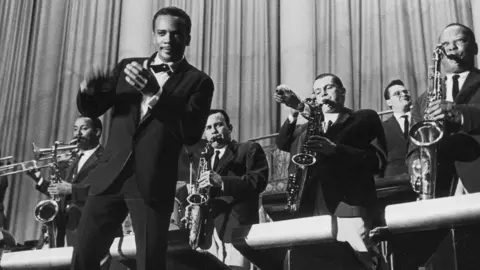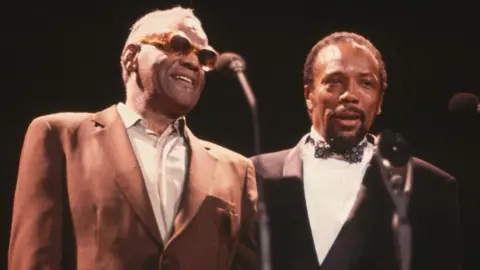
 Getty Images
Getty Images
Quincy Jones lived for 50 years after attending his own memorial service.
When the musician suffered a brain aneurysm in 1974, his chances of survival were said to be so slim, and his stature so high, that his famous friends started planning a tribute concert.
Then aged 41, Jones had already made an indelible mark on American music as a performer, arranger, songwriter, producer, soundtrack composer and record executive.
He started out in the jumping jazz clubs of the 1950s; mastered soul, swing and pop on recordings by Dinah Washington, Frank Sinatra and Lesley Gore; and reached the top 10 in his own right.
Some of the biggest entertainers in America agreed to perform at his memorial.
When he pulled through, the show went ahead anyway.
Jones went along, accompanied by his neurologist, who gave strict instructions not to get too excited.
"That was hard to do with Richard Pryor, Marvin Gaye, Sarah Vaughan and Sidney Poitier singing your praises," he told Newsweek in 2008.
Even more exciting things were yet to come.
Jones went on to forge an era-defining partnership with Michael Jackson; oversee 1985's We Are the World, one of the biggest-selling songs of all time; craft hits for acts like Chaka Khan and Donna Summer; and work with the biggest names in hip-hop.
Few branches of American popular music were immune to his influence.

 Getty Images
Getty Images
Quincy Jones started out playing in and then leading jazz bands
Jones had always been a survivor.
He grew up in the shadow of the Great Depression in the 1930s on the South Side of Chicago. His mother was taken to a psychiatric institution when he was seven and his father worked as a carpenter for notorious gangsters the Jones Boys.
Young Quincy wanted to be a gangster too. "You want to be what you see, and that's all we ever saw," he said.
He and his brother were "street rats" and, when he strayed into the wrong neighbourhood at the age of seven, a rival gang member "nailed my hand to a fence". Another injury came from an ice pick to the face.
His father took the family to Washington state, where one night Quincy and some friends broke into a community centre, looking for food. Inside, there was a piano.
"I touched it and every cell in my body said, this is what you'll do [for] the rest of your life," he told BBC Radio 4's Front Row in 2016.
The encounter "changed my life", he said in conversation with rapper Kendrick Lamar for a 2018 Netflix documentary, adding that, "I would have been dead or in prison a long time ago" if he hadn't discovered music.

 Getty Images
Getty Images
Ray Charles and Quincy Jones started out together in their teens
Quincy immediately began experimenting with instruments at school, settling on the trumpet, and began playing in nightclubs.
At the age of 14, he made friends with another then-unknown musician called Ray Charles, who became a lifelong collaborator.
He also played with Billie Holiday at 14, and got taken under the wings of bandleader Count Basie and trumpeter Clark Terry. He went on to accompany Dizzy Gillespie and appeared in the band during Elvis Presley's first TV appearance.
After showing a talent for arranging songs while touring the world with Lionel Hampton's big band, he was soon in demand in that capacity, too.
But after running up a $145,000 debt on a European tour, he took a day job with Mercury Records in 1961, becoming the first African-American vice-president of a major record label.
While there, he discovered and produced the million-selling single It's My Party by Lesley Gore. He also released the Big Band Bossa Nova compilation album, which included his own infectious track Soul Bossa Nova, which has since become a staple of parties and film soundtracks, including Austin Powers.

 Getty Images
Getty Images
Frank Sinatra called Quincy Jones "one of the finest musicians I've ever known"
Meanwhile, Sinatra had been impressed with Jones's work and called on him to arrange and conduct two of his albums in the 1960s. The pair formed a fertile partnership, with Sinatra calling him "a giant" and "one of the finest musicians I've ever known".
The pair became firm friends outside the studio, too. "Seven double Jack Daniels in an hour... [Sinatra] invented partying," Jones recalled.
Jones also worked with many other big names of the age, including Aretha Franklin, Louis Armstrong and Sammy Davis Jr, while his solo album Body Heat reached the US top 10.
Meanwhile, he was forging a career writing soundtracks for TV shows and films including In Cold Blood, The Italian Job and Roots.
In Cold Blood's author Truman Capote reportedly tried to have Jones removed from the film because he was black. But he remained, and the score earned Jones the first of seven Oscar nominations.
Another soundtrack was The Wiz, the 1978 film musical version of the Wizard of Oz, which starred Diana Ross and a 19-year-old Michael Jackson, who was looking to branch out after finding childhood fame in The Jackson 5.
Jones saw a superstar quality in Jackson and became his producer and mentor, first on 1979's Off the Wall, which was a major hit, and then 1982's Thriller, which reached new heights of commercial and critical success, and made Jackson the undisputed King of Pop.

 Getty Images
Getty Images
Michael Jackson and Diana Ross starred in The Wiz
The album was not just the fulfilment of Jackson's talent, but the culmination of Jones's career, as he used his peerless musical expertise to define the 1980s with a sleek and polished fusion of R&B and pop.
Jones listened to hundreds of songs to decide which nine should go on the album, and employed a dream team of musicians and songwriters that he had been assembling over the years.
His choice of collaborators was one example of his knack for knowing how to make a good song great. For Beat It, he thought the single needed a rockier edge, so he recruited Eddie Van Halen to contribute a guitar solo. Legend has it that the solo was so explosive that a speaker caught fire in the studio.
And when it came to the title track, Jones didn't like the original name Starlight, so he asked its writer, Rod Temperton, to come up with something different. Temperton renamed it Thriller and recast it with a spooky theme. Jones topped it off by asking his wife's friend, horror actor Vincent Price, to record a spoken-word outro.
The album earned Jones and Jackson the Grammy Award for producer of the year, while Thriller was named album of the year and Beat It won record of the year.
Jones used his winning formula in the 1980s with George Benson, Donna Summer and Patti Austin, and produced the decade's best-selling single when Jackson and Lionel Richie assembled 35 of America's biggest names for the 1985 charity song We Are the World.
Jones famously posted a message on the studio entrance telling the stars: "Check your egos at the door".
He had further success under his own name with his albums The Dude and Back on the Block. The latter, released in 1989, featured an all-star cast including many friends from his early career like Ella Fitzgerald, Miles Davis, Dizzy Gillespie and Ray Charles.
But as well as revisiting his past, he was also firmly in the present, enlisting rappers like Ice-T and Grandmaster Melle Mel to appear on the title track.
It earned Jones another album of the year award at the Grammys.
Although he was in his 50s, he embraced rap music because he saw similarities with the energy of bebop jazz, and because may of its stars had risen out of hardship on the streets.
"I feel a kinship there because we went through a lot of the same stuff," he said.
And rap stars reciprocated his affection, looking on Jones as an inspirational elder statesman of black American music. Even Kendrick and Dr Dre were awestruck when meeting him for the Netflix documentary, which was titled Quincy and directed by his daughter, actress Rashida Jones.

 Getty Images
Getty Images
Jones used his status to try to stem the violence in the hip-hop world, convening the Quincy Jones Hip-Hop Symposium in 1995, where he addressed a room full of the nation's rap stars.
"I want to see you guys live at least to my age," he told them.
For Jones, social activism went hand-in-hand with his music.
He met Martin Luther King in 1955, and "from then on, my life was never the same", he said.
"Civil rights work and political involvement was no longer an activity to do on the side. It became an essential part of life and humanity."
He set up the Quincy Jones Listen Up Foundation and launched the We Are the Future project, among support for other causes.
Elsewhere, his redoubtable work ethic saw him launch a record label and hip-hop magazine Vibe, as well as producing films like The Color Purple and TV shows including The Fresh Prince of Bel-Air.
With that workload, and an accompanying longstanding drink problem, his family life and his health both suffered.
He married and divorced three times, having a nervous breakdown after splitting from third wife Peggy Lipton. To recover, he went to stay on the Pacific island owned by actor Marlon Brando, whom he first met in a jazz club at the age of 18.
Jones was also in a relationship with actress and model Nastassja Kinski in the 1990s, and he had seven children in total.
In 2015, he went into a diabetic coma for four days, and the following year went to hospital with a blood clot.
His death on Sunday at the age of 91 has left the music world in mourning.
If there's to be a second Quincy Jones memorial concert, stars will be queuing up to celebrate the full achievements of a singular talent.

 1 month ago
11
1 month ago
11










 English (US) ·
English (US) ·